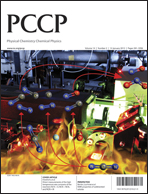We present a Density Functional Theory investigation aimed to model the possible adsorption modes to the TiO2 surface of two representative TPA-based dyes, termed L0 and rh-L0, having the two mostly employed anchoring groups, namely the cyanoacrylic and rhodanine-3-acetic acids respectively. The bidentate coordination with proton transfer to a nearby surface oxygen is found to be the energetically favored anchoring mode for both dyes. The calculations show that the different dye anchoring groups give rise to a very different electronic coupling between the dye and the manifold of unoccupied semiconductor states, thus implying different electron injection mechanisms. The strongly coupled L0 dye possibly shows an adiabatic electron injection mechanism, while a non-adiabatic electron injection can be foreseen for the weakly coupled rh-L0 dye. The different orientation with respect to the TiO2 surface for the two classes of dyes, implying different distances of the donor group from the oxide surface, together with the different electron injection mechanisms might account for the faster recombination reaction measured for the rhodanine-based dyes.

You have access to this article
 Please wait while we load your content...
Something went wrong. Try again?
Please wait while we load your content...
Something went wrong. Try again?


 Please wait while we load your content...
Please wait while we load your content...